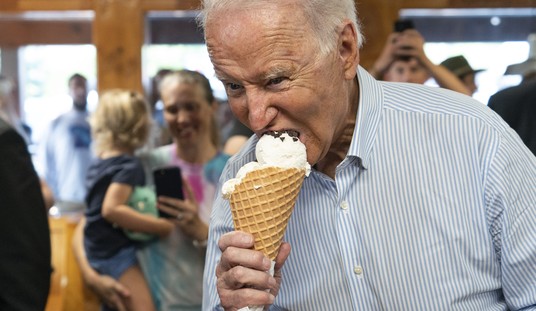Note from Erick: Andy Puzder is CEO of CKE Restaurants, Inc., which employs about 21,000 people at Carl’s Jr. and Hardee’s restaurants. He is co-author of “Job Creation: How it Really Works and Why the Government Doesn’t Understand it.” Puzder serves as co-chair of the American Freedom and Enterprise Foundation.
While the unemployment numbers for June contained some positive news, the coverage to date has obscured the continuing negative trends and ObamaCare’s increasing impact. It’s time to take a realistic look at how the fragility of our economy and the specter of big government are restricting both growth and job creation. The actual state of our labor market is a good place to start.
The “official” unemployment rate held steady at 7.6%. The economy created 195,000 jobs in June. The BLS revised payrolls for the last three months upwards and the labor participation rate (the percentage of the total population over the age of 16 in the labor force) improved slightly moving from 63.4% to 63.5%.
However, there were several very troubling indicators. The number of people who gave up looking for work because they believe no jobs were available increased by 206,000 from a year earlier to 1 million. The number of individuals who were working part time increased by 432,000, twice the number of jobs created. Full time jobs actually declined by 272,000.
In part, this increase in part time jobs and decline in full time jobs reflects a change in hiring practices in anticipation of ObamaCare taking effect. The new law substantially increases the cost of businesses providing employees health insurance but only requires that they provide coverage to full time employees. As result, employers are dividing available hours of work among more jobs, creating more part time employees and reducing the number of full time jobs. This actually reduces the official unemployment rate which counts part time jobs as equal to full time jobs.
Not surprisingly, many of the jobs the economy created last month were service jobs such as restaurant employees and store clerks that are easily converted from full to part time. The official unemployment rate may consider part time and full time jobs as equal, but American workers do not. Of the 432,000 part time jobs created last month, 322,000 went to Americans who wanted full time work but could only find part time work (increasing the total number of people working part time but wanting full time work to 8.3 million).
The BLS also calculates an unemployment rate that includes all persons who have searched for work during the prior twelve months (as opposed to the official rate’s 30 day cut off), plus all people who want a full-time job but are employed part-time for “economic reasons,” such as reduced hours or an inability to find a full-time job. This is known as the U6 unemployment rate and it is the widest measure the government calculates.
While, the impact of ObamaCare turning full time jobs into part time jobs decreases the official unemployment rate, it increases the U6 rate to the extent that people working part time jobs are doing so because they are unable to find full time jobs. As noted above, that number increased by 322,000 people in June to 8.3 million. Not surprisingly then, the U6 measure of unemployment significantly increased rising from 13.8% in May to 14.3% in June, clear evidence that the labor market is getting worse for people who want a full time job, probably because of Obamacare
The decline in the labor participation rate also hides the labor market’s anemic state. The recession’s unemployment rate peaked in October of 2009 at 10% when the labor participation rate was 65%. Had the participation rate continued at 65%, the “official” unemployment rate in June would have been 9.7% rather than 7.6%. In other words, the labor market hasn’t materially improved in the nearly four years since unemployment peaked in October of 2009; rather the unemployment rate has declined because a smaller percentage of the total population is now in the labor force. The question is then: Why has the labor participation rate declined?
Some claim that as baby boomers are retiring and leaving the labor force, the participation rate will naturally decline. But the Boston Federal Reserve published a study recently finding that the bulk of the decline in labor-force-participation is due to economic factors (a declining economy) rather than demographic ones (an increase in retirees). The BLS reports a number each month which it labels “Not in the Labor Force – Want a Job Now” that seems to confirm this study’s conclusion.
According to the BLS, in June there were 6,580,000 people out of work who “want a job now” but who BLS excluded from the ranks of the officially unemployed, including those who were too discouraged to look for a job in the past 30 days. Adding these people back into the labor force produces an unemployment rate of 11.3%, again well in excess of the “official” 7.6%.
Michael Talent and I have previously written about the unreliability of the “official” unemployment rate and the significance of a labor force that has dwindled to Carter era lows as a percentage of the total population. We have advocated a new and more reliable metric to measure the labor market’s performance that we call the “Growth Ratio”. We publish the Growth Ratio each month on line. http://growthratio.com/.
The Growth Ratio is the year-over-year growth in the number of jobs (measured through the BLS’s household survey) divided by the year-over-year growth in the civilian non-institutional population (the number of people who could be in the labor force). This fraction tells us whether job creation is keeping pace with, running ahead of, or falling behind population growth. Like the official rate, the Growth Ratio considers full and part time work equally. As such, it may actually overstate the strength of the labor market but is nonetheless an effective measure of the relationship between job creation and population growth.
A growth ratio equal to one indicates that employment grew as fast as the population; in that case, the real unemployment rate should remain unchanged. A growth ratio above one indicates job growth in excess of population growth, which should reduce the number of unemployed people and result in a lower unemployment rate. A ratio lower than one indicates that employment either fell or grew but failed to keep pace with population growth; in that case, an honest assessment of labor market health should show that unemployment has gone up.
In June, the growth ratio clocked in at 1.15%, indicating that employment growth over the previous twelve months was slightly greater than population growth. The average for the recovery to date is a dismal 0.97%. In other words, the labor market has actually gotten slightly worse since the recovery began. Yet the early years of a recovery should be its most robust, especially where a recession was severe. Considering the loss in employment during the last recession, the growth ratio should be consistently hitting 1.5% or better, as it did following prior recoveries once the Growth Ratio went positive.
In short, real unemployment is well above the “official” 7.6%. The official rate has only declined because of a very disturbing decline in the number of people the BLS considers in the labor force. In addition, as employers divide the number of available full time work hours among a larger group of part time workers, the official unemployment rate makes it appear as though our economy is growing and creating more jobs than it is. Dividing full time jobs into more numerous part time jobs is not an indication of economic growth. Yet, even with this false positive, job creation is barely exceeding population growth.
What misleadingly appears to be an improvement in the labor market is actually stagnation at best. This is not a labor market in recovery. It’s an economy in serious trouble and disturbingly unprepared for any future crises. Big government as a solution has failed. It’s time to re-energize the private sector with tax and regulatory policies that make sense.













Join the conversation as a VIP Member